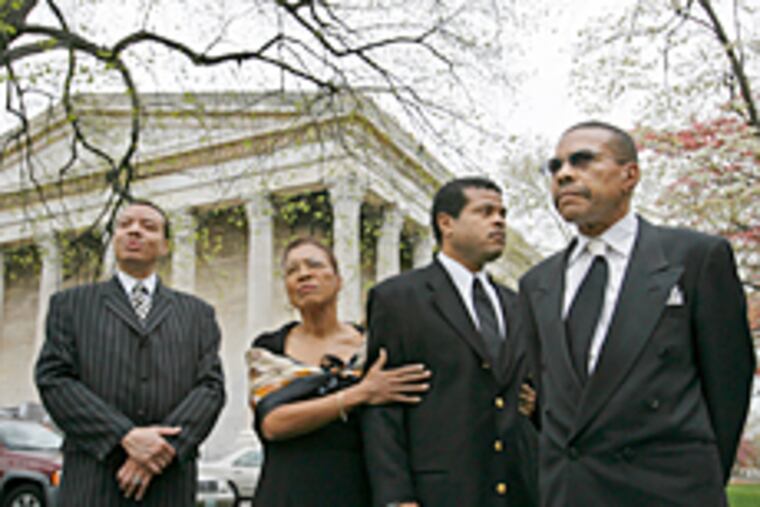A farewell to a pioneer
Marie Hicks, 83, the "Rosa Parks of Girard College,&" circled the 10-foot wall of the school for the last time yesterday.

Marie Hicks, 83, the "Rosa Parks of Girard College," circled the 10-foot wall of the school for the last time yesterday.
The hearse carrying her body led 10 of the cars in the funeral cortege in which her three sons, daughter and others rode. It proceeded through Girard's front gate, past Founder's Hall, and briefly paused at the foot of the statue of Stephen Girard and Founder's Hall.
The procession ended at Mrs. Hicks' final resting place, Beverly National Cemetery in Burlington County.
Family and friends gathered at Girard following the burial.
In 1965, Mrs. Hicks, whose husband had died the year before, wanted to enroll two of her sons in Girard College. The founder, wealthy merchant and banker Stephen Girard, left his fortune in 1831 to establish a school "in which poor, white male orphans could be housed and educated."
In 1954 U.S. Supreme Court ruled in Brown v. Board of Education that educating black and white children separately was unconstitutional. That year, a suit was filed to seek admission to Girard for six African American students.
In 1956, a state Supreme Court ruled that "a man's prejudices are part of his liberty" and Girard remained segregated.
The will was contested again in 1957. The U.S. Supreme Court ruled that Girard's whites-only provision was illegal and that the school could not discriminate because the Board of City Trusts, which oversees the school, was a state agency. The case was returned to the lower courts. Orphans' Court created a private body to oversee the school to avoid integrating Girard.
In 1965, Cecil B. Moore, president of the Philadelphia NAACP, and lawyer William T. Coleman recruited Mrs. Hicks and three other parent plaintiffs to file a suit in U.S. District Court on behalf of seven African American students. Mrs. Hicks led protesters, including the Rev. Dr. Martin Luther King Jr., in marches around the 10-foot wall surrounding Girard College for a year.
In 1968, the U.S. Supreme Court ruled that African American boys could be admitted to Girard College. That year, four boys, including Theodore Hicks and, four months later, Charles Hicks, enrolled at Girard.
Mrs. Hicks died last Thursday of Parkinson's disease.
Son Theodore, 48, who in 1977 became Girard College's first black valedictorian, said yesterday, "It was very emotional for me today to come through the gates of Girard without my mother. All of the emotions of Sept. 11, 1968, when I walked in holding my mother's hand, came back. For the first month, students were not allowed to leave the campus. I felt so alone. I wanted to go home to my mother."
Theodore, who earned a bachelor's degree in foreign studies from Georgetown University, is a self-employed legal investigator who lives in the Washington area.
Earlier in the day, during Mrs. Hicks' funeral at Faith Tabernacle Baptist Church in North Philadelphia, she was eulogized by family members; Dominic M. Cermele, the president of Girard College; William T. Coleman, the lawyer who with Cecil B. Moore recruited Mrs. Hicks and three other parent plaintiffs in 1965; and Kenneth Salaam, one of the Freedom Fighters who skipped high school classes in 1965-66 to march at Girard College in protest of the ban on black students.
Son Charles, 50, the first black graduate of Girard College in 1974, recently retired from Ford Motor Co., where he was an engineer. He earned a bachelor's degree in engineering from Georgia Institute of Technology. He now mentors students across the country and encourages them to enter NASA's Explorer Program.
"In memory of and to carry on my mother's and others' efforts to integrate Girard College, we have formed a foundation to help Girard graduates fund their higher education," Charles said. "I don't want people to forget what those before us went through to fight for civil rights. Even though African American students are now in the majority at Girard, I want students of all colors to feel welcome."
The student population of Girard College today is 726 students: 83.7 percent African American; 4.8 percent Asian; 1 percent Caucasian; 3.3 percent Latino; 4.8 percent multiracial; 2.1 percent other; and .3 percent unknown. (These are self-declared racial descriptions by parents and students.)
Mrs. Hicks' daughter, Loretta Hicks Mason, 58, who earned a bachelor's in education from Cheyney State University, taught fourth grade in Philadelphia public schools for 35 years before retiring to Fort Lauderdale, Fla.
She said yesterday, "I'm thrilled to see so many female students at Girard."
The sex barrier was broken in 1983. Girls make up 53.4 percent of the student population.
Mrs. Hicks' eldest child, Junius Jr., 57, was too old for entry into Girard. He earned a bachelor's from Virginia State University and a law degree from Howard University. He is studying for a master's in business administration at La Salle University. His mother earned a bachelor's in sociology from La Salle when she was 58. She attended classes at night while working as a maid at La Salle.
Donations may be made to Girard College Development Fund, in care of the Cecil B. Moore-Marie Hicks Award Fund, 2101 S. College Ave., No. 307, Philadelphia 19121-4860.